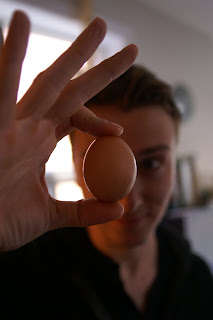
The concept of the “3000-mile Caesar salad” has always perplexed me some. Between shipping costs, seasonal differences and a general lack of support for local farmers, the entire construct seems both irresponsible and completely unnecessary. It’s with this in mind that I can very proudly (and gratefully) say that there is a grand total of 20 feet between our eggs and my frying pan.
Paul was the first to discover our very first egg. I wasn’t there, but he insists that the noise he made was far louder than anything that has come from the chickens thus far. Somewhere between a gasp and guttural moan, I imagine.
The eggs, at least at this stage, are still quite small. A size you would never see in your grocery store, if I’m honest, but there’s really something so special feeling about plucking a still-warm egg from your backyard coop – regardless of how hungry you may still be afterwards. A little wash-up and a lot of excitement later, and we were ready for our first taste. We gathered around a very buttery pan, cracked Baylik’s spherical bounty, and all waited with wide eyes for the white to go opaque.
Initial impressions are that you really can’t match this level of freshness. The yolk clings very tightly to the white (normally after a few days, the yolk becomes easier and easier to separate), the color is a bright yellow, you almost want to swig it down raw, Rocky-style. The yolk is rich and coats your mouth with a mineral-ish taste, the whites basically taste like butter, but the general consensus is that they have a “warm” texture, very viscous and molten.

For the first while, Baylik was the only one to lay anything for us, because she is the older hen. More recently, however, a trip to the coop yields contributions from Hebsebah as well. Equally delicious, equally exciting. Jacob and Paul have even started stamping the eggs with our blog address.
Frequently asked questions:
How are you getting eggs without a rooster? We don’t need one. We’re getting one a day from each hen, roughly, they’re just not fertilized.
Can they fly? No, but they will give a flappy jump if you hold a worm in front of them.
Do they have personalities? Oh yeah. Baylik is a total rebel, usually the first to explore things, and will be the most fervent out of the gate when you open it. Hebsebah is a little more tame, but a bit louder. This might be due to younger age.
Long story short, the eggs are delicious, and they come from very happy chickens.
















